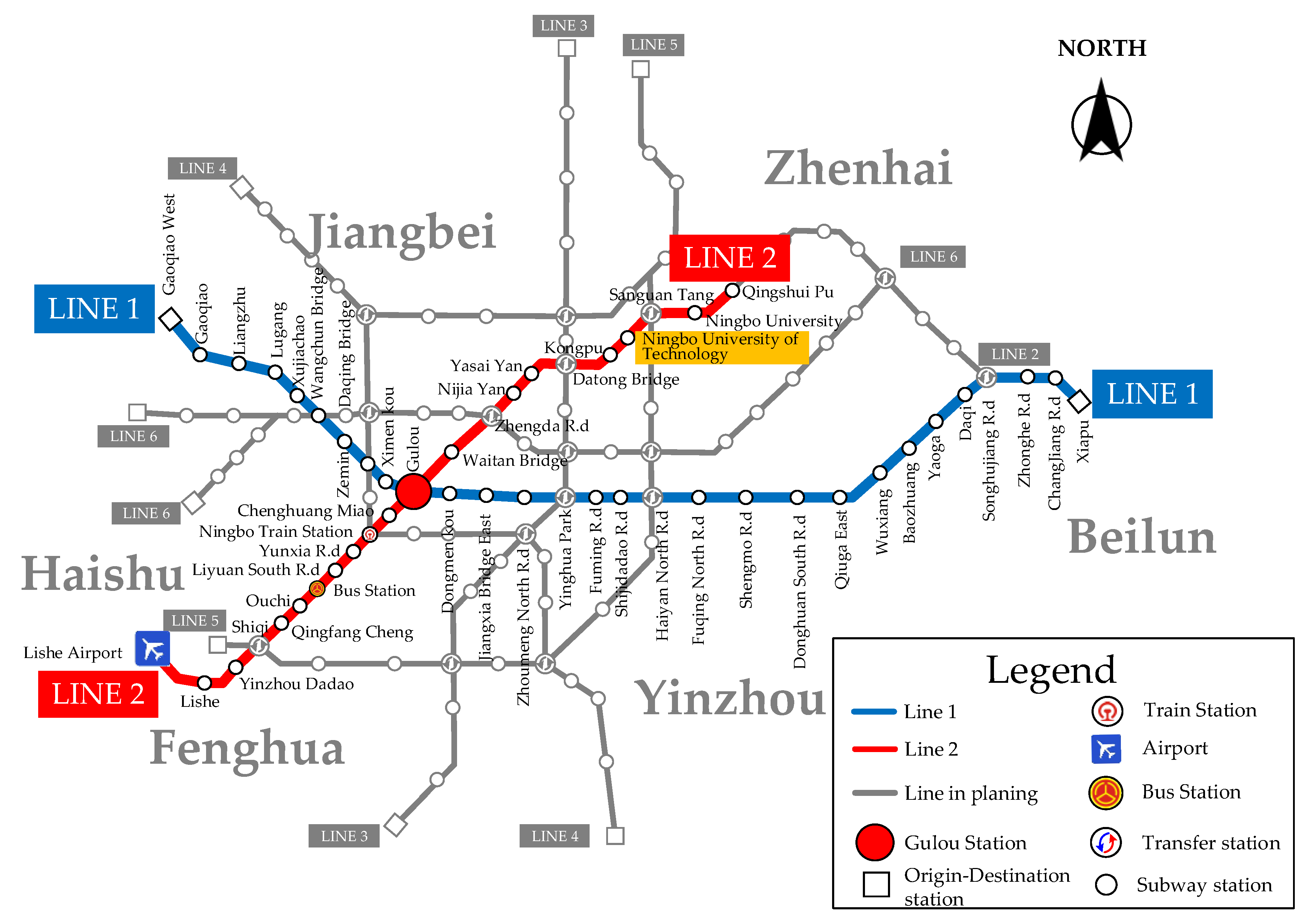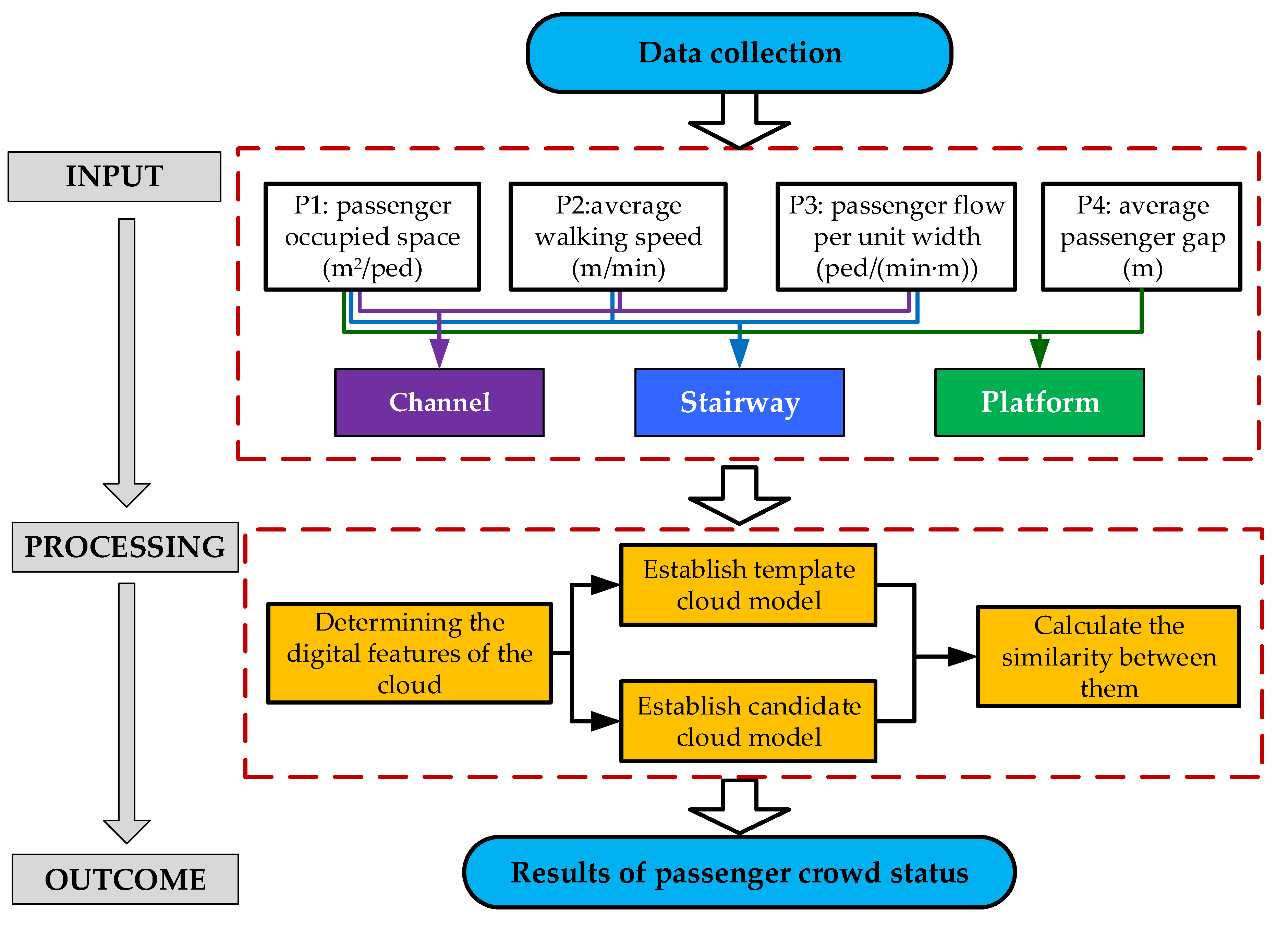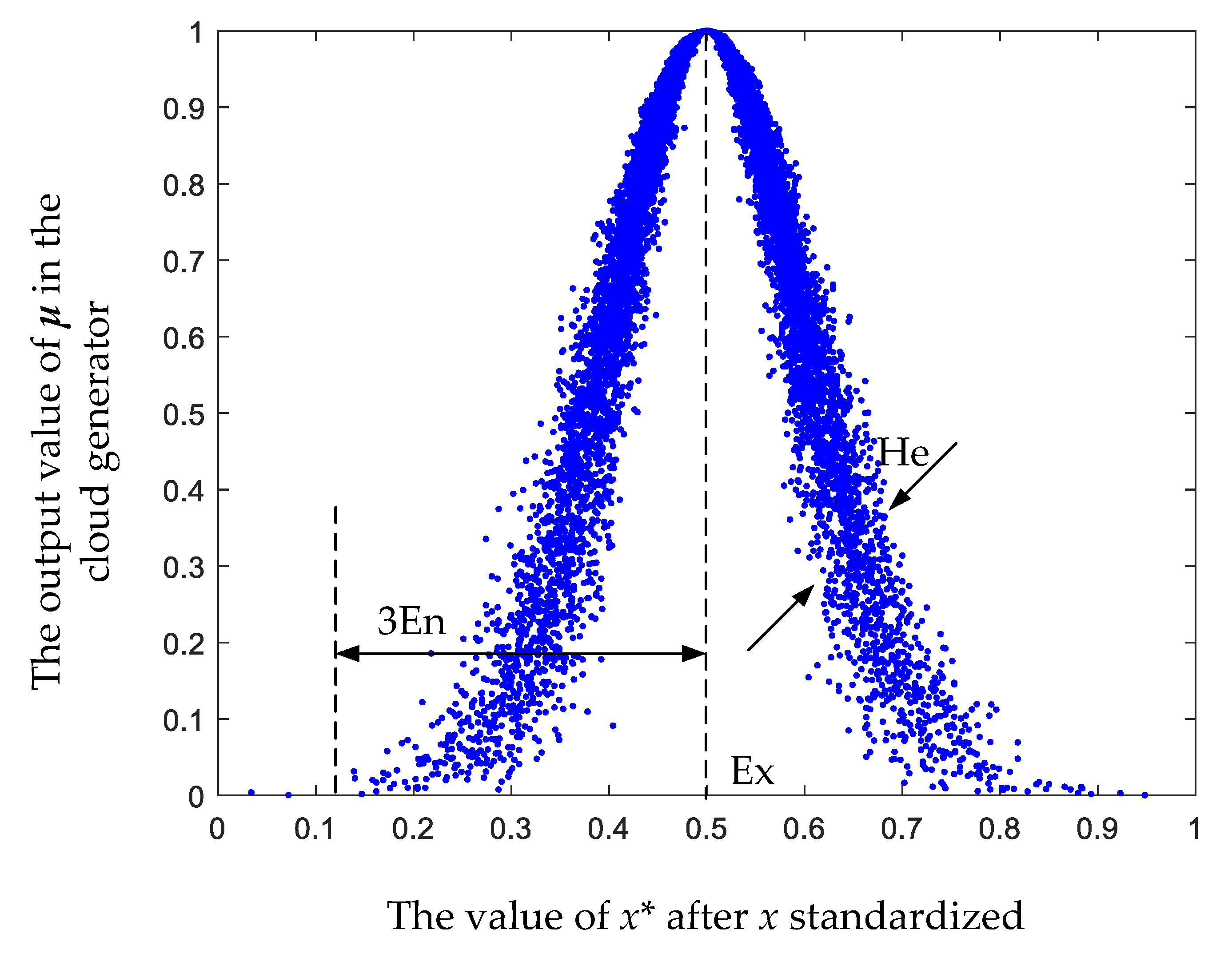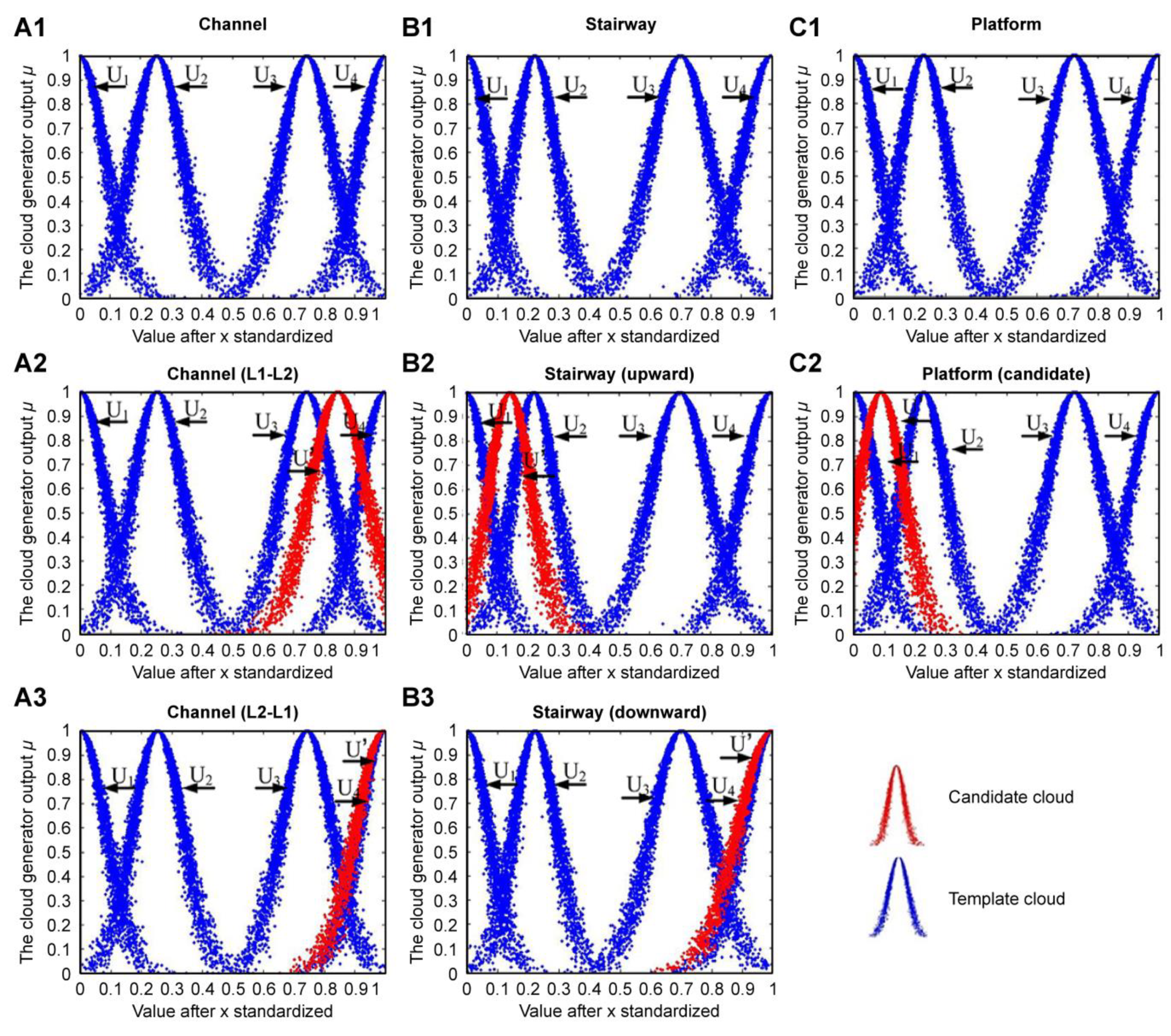Congestion Evaluation of Pedestrians in Metro Stations Based on Normal-Cloud Theory
Abstract
Featured Application
Abstract
1. Introduction
2. Literature Review
2.1. Impacts of Passenger Crowding
2.2. Measures to Track Passenger Crowding
3. Data
3.1. Data Collection
3.2. Data Results
4. Methodology
4.1. Problem Statements
- Uncertainty: As at least two indicators were used for each facility, the congestion assessment results were different when applying the criterion in Table 1. Taking the crowding assessment in the channel as an example, the LOS was C when using P1 = 2.29 m2/ped. When using P2 = 63.50 m/min, the LOS was E. When using P3 = 25.63 ped/(min·m), the LOS was B. Thus, uncertainty was seen in the assessment as a same indictor resulting in different LOS results.
- Ambiguity: No agreements existed on the criteria of the LOS assessment. Although the TCQSM, 2nd Edition [33] provided the division of the index for each facility, it was mainly based on the situation in the United States. Thus, it was weak for the practice guidance of China’s rail transit. An accurate and reasonable threshold division as to when to determine the grade of crowd for a certain passenger flow is still lacking. Thus, ambiguity was seen in the congestion assessment.
4.2. Model Framework
4.3. NC Model
- Cloud model: Let be a quantitative domain and let be a qualitative concept on . If a certain value , then x is a random implementation of . The determinacy of x to is a random number with a stable tendency : →[0, 1], ∀ , x→. Then, the distribution of x on the domain is called a cloud, and each x is described as a cloud droplet. Three parameters, the expectation Ex, the entropy En, and the super-entropy He, are used to characterize the normal-cloud model, as shown in Figure 5.
- NC generator: If the definition of x in the cloud satisfies x~N(Ex, En’) and En’~N(En, He2), the determinacy of x to satisfies the following:
- 3.
- Cloud synthesis: The synthesis of clouds was to combine the clouds of the same nature with a parent cloud. The parent cloud C (Ex, En, He) was synthesized using n child clouds Cn (Exn, Enn, Hen), expressed as follows:where “◦” refers to the process of cloud synthesis and wi to the weight of the i-th child cloud.
- 4.
- Model of GPC: The process of the model followed five steps:
- Establish a forward cloud generator CGXj, according to the digital features of the GPC index in the rail station.
- Standardize the actual values x collected by the index and marked as x*. Let the standardization results of index in x ≤ min {} be 0 and index in x ≥ min {} be 1.
- Input the standardized values x* into the forward NC generators, as shown in Figure 7, for the operating principle of the forward NC generator.
- Output of the cloud generator, (j = 1, 2, …, n), represents the degree of x belonging to Xj. The fuzziness and randomness nature of the NC model indicates that, instead of a determined number, is a random number with a stable tendency. After normalizing all , Equation (8) shows the weights for each :Using the digital features of the child clouds calculated from Equation (3), cloud Xx (ExX, EnX, HeX) is obtained where x is the input.
- Calculate the three digital features of the candidate clouds for other indexes in the rail transit station using Steps (1) to (3).
- Synthesize the candidate cloud U’ so that U’ = Rr ◦ Ss ◦ Tt = (Ex, En, He), as referred to in Equation (10), where Rr, Ss, and Tt are the clouds calculated by each index.
- Generate normal random numbers Eni’ in the candidate cloud, with the expected value En and the variance He2, that is, Eni’ = N (En, He2).
- Generate normal random numbers xi in the candidate cloud, with the expected value Ex and the variance Eni’2, that is, xi = N (Ex, Eni’2).
- Generate normal random numbers Enj in the template cloud, with the expected value Enj and the variance Hej2, that is, Enj’ = N (Enj, Hej2).
- Calculate the degree of the membership (βij) for the j-th GPC, that is, βij = exp [−(xi − Exj)2/2 Enj’2].
- Repeat Steps (1) to (4) until n members of clouds are generated.
- Calculate the cloud similarity δj between the candidate cloud U’ and each template cloud Uj, as follows:
- Normalize using Equation (9). The possible GPC that the candidate cloud belongs to is indicated by and calculated as follows:
4.4. Model Results and Discussion
- Channel: The measured degrees of the membership for the four grades were 0.3970, 0.6030, 0.0000, and 0.0000 in the L1–L2 direction, which inclined to grade II. However, the measured degrees of the membership for the four grades were 0.8836, 0.1164, 0.0000, and 0.0000 in the L2–L1 direction, which inclined to grade I.
- Stairway: The measured degrees of the membership for the four grades were 0.0000, 0.0001, 0.6570, and 0.3429 in the upward direction, which inclined to grade III. However, the measured degrees of the membership for the four grades were 0.8843, 0.1157, 0.0000, and 0.0000 in the downward direction, which inclined to grade I.
- Platform: The measured degrees of the membership for the four grades were 0.0000, 0.0000, 0.3594, and 0.6406, which inclined to grade IV.
4.5. Crowd Management Measures
5. Conclusions
Data Availability
Author Contributions
Funding
Conflicts of Interest
References
- Xu, H.; Jiao, L.; Chen, S.; Deng, M.; Shen, N. An innovative approach to determining high-risk nodes in a complex urban rail transit station: A perspective of promoting urban sustainability. Sustainability 2018, 10, 2456. [Google Scholar] [CrossRef]
- China Urban Rail Transit Association; Annual Report of China Urban Mass Transit; China Association of Metros: Beijing, China, 2019.
- Zeng, L.; Liu, J.; Qin, Y.; Wang, L.; Yang, J. A passenger flow control method for subway network based on network controllability. Discret. Dyn. Nat. Soc. 2018, 2018, 1–12. [Google Scholar] [CrossRef]
- Yang, X.; Chen, A.; Ning, B.; Tang, T. Measuring route diversity for urban rail transit networks: A case study of the Beijing metro network. IEEE Trans. Intell. Transp. Syst. 2017, 8, 259–268. [Google Scholar] [CrossRef]
- Huang, J.; Zhou, F.; Xi, M. Calculation method for load capacity of urban rail transit station considering cascading failure. J. Adv. Transport. 2018, 2018, 1–12. [Google Scholar] [CrossRef]
- Guo, Y.; Li, Z.; Liu, P.; Wu, Y. Modeling correlation and heterogeneity in crash rates by collision types using full Bayesian random parameters multivariate Tobit model. Accid. Anal. Prev. 2019, 128, 164–174. [Google Scholar] [CrossRef] [PubMed]
- Guo, Y.; Essa, M.; Sayed, T.; Haque, M.; Washington, S. A comparison between simulated and field-measured conflicts for safety assessment of signalized intersections in Australia. Transp. Res. Part C Emerg. Technol. 2019, 101, 96–110. [Google Scholar] [CrossRef]
- Kyriakidis, M.; Hirsch, R. and Majumdar, A. Metro railway safety: An analysis of accident precursors. Saf. Sci. 2012, 50, 1535–1548. [Google Scholar] [CrossRef]
- Shen, W.; Xiao, W.; Wang, X. Passenger satisfaction evaluation model for Urban rail transit: A structural equation modeling based on partial least squares. Transp. Policy 2016, 46, 20–31. [Google Scholar] [CrossRef]
- Guo, Y.; Li, Z.; Wu, Y.; Xu, C. Evaluating factors affecting electric bike users’ registration of license plate in China using Bayesian approach. Transp. Res. Part F Traffic Psychol. Behav. 2018, 59, 212–221. [Google Scholar] [CrossRef]
- Ma, C.; Hao, W.; Wang, A.; Zhao, H. Developing a coordinated signal control system for urban ring road under the vehicle-infrastructure connected environment. IEEE Access 2018, 6, 52471–52478. [Google Scholar] [CrossRef]
- Chen, F.; Chen, S.; Ma, X. Analysis of hourly crash likelihood using unbalanced panel data mixed logit model and real-time driving environmental big data. J. Saf. Res. 2018, 65, 153–159. [Google Scholar] [CrossRef] [PubMed]
- Ma, X.; Chen, S.; Chen, F. Multivariate space-time modeling of crash frequencies by injury severity levels. Anal. Methods Accid. Res. 2017, 15, 29–40. [Google Scholar] [CrossRef]
- Niu, H.; Zhou, X. Optimizing urban rail timetable under time-dependent demand and oversaturated conditions. Transp. Res. Part C Emerg. Technol. 2013, 36, 212–230. [Google Scholar] [CrossRef]
- Ma, C.; Yang, D.; Zhou, J.; Feng, Z.; Yuan, Q. Risk riding behaviors of urban e-bikes: A literature review. Int. J. Environ. Res. Public Health. 2019, 16, 2308. [Google Scholar] [CrossRef] [PubMed]
- Chen, F.; Chen, S. Injury severities of truck drivers in single-and multi-vehicle accidents on rural highways. Accid. Anal. Prev. 2011, 43, 1677–1688. [Google Scholar] [CrossRef] [PubMed]
- Mahudin, N.D.M.; Cox, T.; Griffiths, A. Measuring rail passenger crowding: Scale development and psychometric properties. Transp. Res. Part F Traffic Psychol. Behav. 2012, 15, 38–51. [Google Scholar] [CrossRef]
- Haywood, L.; Koning, M.; Monchambert, G. Crowding in public transport: Who cares and why? Transp. Res. Part A Policy Pract. 2017, 100, 215–227. [Google Scholar] [CrossRef]
- Kang, L.; Meng, Q. Two-phase decomposition method for the last train departure time choice in subway networks. Transp. Res. B Meth. 2017, 104, 568–582. [Google Scholar] [CrossRef]
- He, L.; Liang, Q.; Fang, S. Challenges and innovative solutions in urban rail transit network operations and management: China’s Guangzhou metro experience. Urban Rail Transit. 2016, 2, 33–45. [Google Scholar] [CrossRef]
- Zhou, J.; Chen, H.; Yang, J.; Yan, J. Pedestrian evacuation time model for urban metro hubs based on multiple video sequences data. Math. Probl. Eng. 2014, 2014, 1–11. [Google Scholar] [CrossRef]
- Jiang, S.; Sun, Y.; Du, Y. The influence of congestion on the choice of public transport mode. J. Tung-chi Univ. Nat. Sci. 2012, 40, 1831–1835. [Google Scholar]
- Basu, D.; Hunt, J. Valuing of attributes influencing the attractiveness of suburban train service in Mumbai city: A stated preference approach. Transp. Res. Part A Policy Pract. 2012, 46, 1465–1476. [Google Scholar] [CrossRef]
- Tirachini, A.; Hensher, D.A.; Rose, J. Crowding in public transport systems: Effects on users, operation and implications for the estimation of demand. Transp. Res. Part. A Policy Pract. 2013, 53, 36–52. [Google Scholar] [CrossRef]
- Yang, J.; Hou, Z. A grey Markov based on large passenger flow real-time prediction model. J. Beijing Jiaotong Univ. 2013, 2, 23–30. [Google Scholar]
- Lam, W.H.; Cheung, C.Y.; Lam, C. A study of crowding effects at the Hong Kong light rail transit stations. Transp. Res. Part A Policy Pract. 1999, 33, 401–415. [Google Scholar] [CrossRef]
- Cao, S.; Yuan, Z.; Zhang, C.; Li, Z. LOS classification for urban rail transit passages based on passenger perceptions. J. Transp. Syst. Eng. Inf. Tech. 2009, 9, 99–104. [Google Scholar] [CrossRef]
- Chen, P.; Zeng, W.; Yu, G. Assessing right-turning vehicle-pedestrian conflicts at intersections using an integrated microscopic simulation model. Accid. Anal. Prev. 2019, 129, 211–224. [Google Scholar] [CrossRef] [PubMed]
- Grisé, E.; El-Geneidy, A. Where is the happy transit rider? evaluating satisfaction with regional rail service using a spatial segmentation approach. Transp. Res. Part A Policy Pract. 2018, 114, 84–96. [Google Scholar] [CrossRef]
- Birago, D.; Mensah, S.O.; Sharma, S. Level of service delivery of public transport and mode choice in Accra, Ghana. Transp. Res. Part F Traffic Psychol. Behav. 2017, 46, 284–300. [Google Scholar] [CrossRef]
- Pel, A.J.; Bel, N.H.; Pieters, M. Including passengers’ response to crowding in the Dutch national train passenger assignment model. Transp. Res. Part A Policy Pract. 2014, 66, 111–126. [Google Scholar] [CrossRef]
- Tirachini, A.; Sun, L.; Erath, A.; Chakirov, A. Valuation of sitting and standing in metro trains using revealed preferences. Transp. Policy 2016, 47, 94–104. [Google Scholar] [CrossRef]
- TRB. Transit Capacity and Quality of Service Manual, 2nd ed.; Transportation Research Board: Washington, DC, USA, 2003. [Google Scholar]
- Li, Z.; Hensher, D. Crowding in public transport: A review of objective and subjective measures. J. Public Trans. 2013, 16, 1–28. [Google Scholar] [CrossRef]
- Jiang, C.S.; Deng, Y.F.; Hu, C.; Chow, W. Crowding in platform staircases of a subway station in China during rush hours. Saf. Sci. 2009, 47, 931–938. [Google Scholar] [CrossRef]
- Zhang, Q.; Han, B.; Li, D. Modeling and simulation of passenger alighting and boarding movement in Beijing metro stations. Transp. Res. Part C Emerg. Technol. 2008, 16, 635–649. [Google Scholar] [CrossRef]
- Guo, Y.; Zhou, J.; Wu, Y.; Li, Z. Identifying the factors affecting bike-sharing usage and degree of satisfaction in Ningbo, China. PLoS ONE 2017, 12, e0185100. [Google Scholar] [CrossRef] [PubMed]
- Hoogendoorn, S.P.; Daamen, W. Pedestrian behavior at bottlenecks. Transp. Sci. 2005, 39, 147–159. [Google Scholar] [CrossRef]
- Daamen, W.; Hoogendoorn, S. Experimental research of pedestrian walking behavior. Transp. Res. Rec. J. Transp. Res. B 2003, 2003, 20–30. [Google Scholar] [CrossRef]
- Li, D.; Liu, C.; Gan, W. A new cognitive model: Cloud model. Int. J. Intell. Syst. 2009, 24, 357–375. [Google Scholar] [CrossRef]
- Zhou, J.; Mao, X.; Wang, Y.; Zhang, M.; Dong, S. Risk assessment in urban large-scale public spaces using dempster-shafer theory: An empirical study in Ningbo, China. Int. J. Environ. Res. Public Health 2019, 16, 2942. [Google Scholar] [CrossRef]
- Dai, C.; Zhu, Y.; Chen, W.; Lin, J. Cloud model based genetic algorithm and its applications. Acta Electron. Sinica 2007, 35, 1419. [Google Scholar]
- Zuo, Z.; Yin, W.; Yang, G.; Zhang, Y.; Yin, J.; Ge, H. Determination of bus crowding coefficient based on passenger flow forecasting. J. Adv. Transp. 2019, 2019, 1–12. [Google Scholar] [CrossRef]
- Klanjšček, J.; Geček, S.; Marn, N.; Legović, T.; Klanjšček, T. Predicting perceived level of disturbance of visitors due to crowding in protected areas. PLoS ONE 2018, 13, e0197932. [Google Scholar] [CrossRef] [PubMed]








| LOS | Channel | Stairway | Platform | ||||
|---|---|---|---|---|---|---|---|
| P1 | P2 | P3 | P1 | P3 | P1 | P4 | |
| A | ≥3.3 | >79 | 0–23 | ≥1.9 | ≤16 | ≥1.2 | ≥1.2 |
| B | 2.3–3.3 | 76–79 | 23–33 | 1.4–1.9 | 16–23 | 0.9–1.2 | 1.1–1.2 |
| C | 1.4–2.3 | 73–76 | 33–49 | 0.9–1.4 | 23–33 | 0.7–0.9 | 0.9–1.1 |
| D | 0.9–1.4 | 69–73 | 49–66 | 0.7–0.9 | 33–43 | 0.3–0.7 | 0.6–0.9 |
| E | 0.5–0.9 | 46–69 | 66–82 | 0.4–0.7 | 43–56 | 0.2–0.3 | 0.6 |
| F | <0.5 | <46 | vary | <0.4 | vary | ≤0.2 | vary |
| Facility | Direction | Matrix | Original Value | Normalized Value |
|---|---|---|---|---|
| Channel | L1-L2 | P1 | 2.290 | 1.000 |
| P2 | 62.000 | 0.574 | ||
| P3 | 25.630 | 1.000 | ||
| L2-L1 | P1 | 109.440 | 1.000 | |
| P2 | 100.000 | 1.000 | ||
| P3 | 0.000 | 1.000 | ||
| Stairway | upward | P1 | 0.410 | 0.000 |
| P3 | 45.600 | 0.318 | ||
| downward | P1 | 11.130 | 1.000 | |
| P3 | 1.670 | 1.000 | ||
| Platform | P1 | 0.390 | 0.180 | |
| P4 | 0.360 | 0.000 | ||
| Facility | Ex | En | He | ε | GPC | Status Description | Comfort Perception | |
|---|---|---|---|---|---|---|---|---|
| Channel | L1-L2 | 0.846 | 0.092 | 0.010 | 2.8 | II | Relatively unimpeded | Good |
| L2-L1 | 0.996 | 0.093 | 0.010 | 1.5 | I | Completely unimpeded | Excellent | |
| Stairway | upward | 0.143 | 0.070 | 0.010 | 7.1 | III | Slightly impeded | Ok |
| downward | 0.996 | 0.111 | 0.010 | 1.6 | I | Completely unimpeded | Excellent | |
| Platform | 0.087 | 0.075 | 0.010 | 7.9 | IV | Heavily impeded | Bad | |
| Facility | Index | LOS | GPC | |
|---|---|---|---|---|
| Channel | L1–L2 | P1 | B | II |
| P2 | E | |||
| P3 | B | |||
| L2–L1 | P1 | A | I | |
| P2 | A | |||
| P3 | A | |||
| Stairway | Upward | P1 | E | III |
| P3 | E | |||
| Downward | P1 | A | I | |
| P3 | A | |||
| Platform | P1 | D | IV | |
| P4 | E | |||
© 2019 by the authors. Licensee MDPI, Basel, Switzerland. This article is an open access article distributed under the terms and conditions of the Creative Commons Attribution (CC BY) license (http://creativecommons.org/licenses/by/4.0/).
Share and Cite
Zhou, J.; Wu, Y.; Mao, X.; Guo, S.; Zhang, M. Congestion Evaluation of Pedestrians in Metro Stations Based on Normal-Cloud Theory. Appl. Sci. 2019, 9, 3624. https://doi.org/10.3390/app9173624
Zhou J, Wu Y, Mao X, Guo S, Zhang M. Congestion Evaluation of Pedestrians in Metro Stations Based on Normal-Cloud Theory. Applied Sciences. 2019; 9(17):3624. https://doi.org/10.3390/app9173624
Chicago/Turabian StyleZhou, Jibiao, Yao Wu, Xinhua Mao, Shun Guo, and Minjie Zhang. 2019. "Congestion Evaluation of Pedestrians in Metro Stations Based on Normal-Cloud Theory" Applied Sciences 9, no. 17: 3624. https://doi.org/10.3390/app9173624
APA StyleZhou, J., Wu, Y., Mao, X., Guo, S., & Zhang, M. (2019). Congestion Evaluation of Pedestrians in Metro Stations Based on Normal-Cloud Theory. Applied Sciences, 9(17), 3624. https://doi.org/10.3390/app9173624





